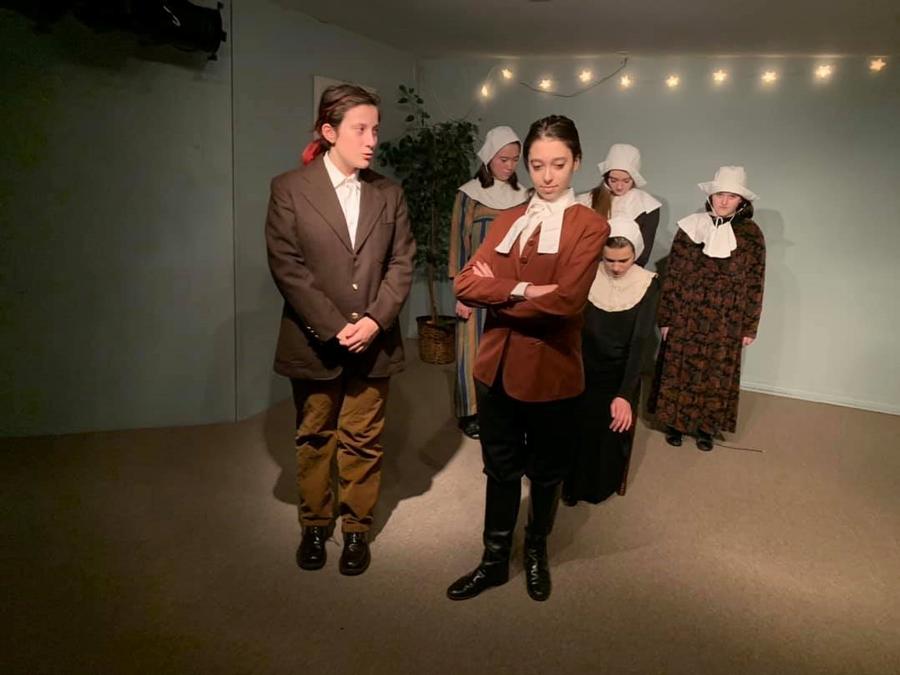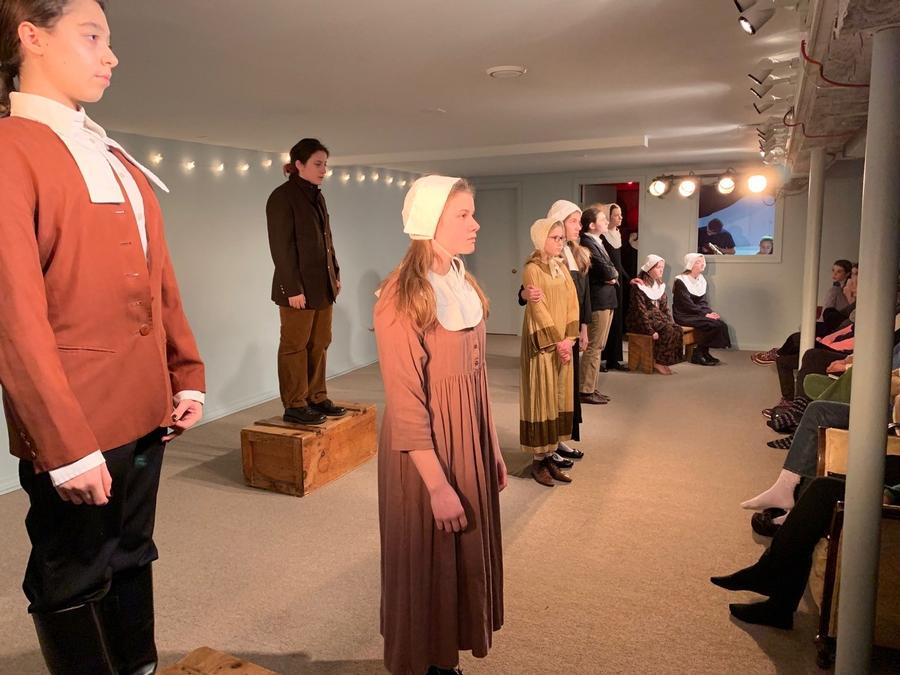Review of The Girls of Salem

I interviewed Roberta about the process. Here are my questions and her responses.
How did you come up with the idea of writing a play about the Salem witchcraft trials?
“I wanted the kids to do a serious play this year. We watched The Crucible, which I directed ten years ago. With the main character being a man and a key plot point being an affair, we decided this group was too young. So I suggested writing a play myself more from the point of view of the girls. It ended up being quite focused on the girls in Act 1 and the accused adults in Act 2.”
What were your sources?
“I read about six books on the Salem Witch Trials and used a number of really great on-line sources. I compared/contrasted accounts to make sure the play was historically accurate. I made just a few adjustments but the trial scenes are straight from the historical records with poetic license taken in the private conversations.”
Have you talked to the actors about how they relate to this play? If so, do you think they understand how the tragedy happened? Have many of them read The Crucible or Lord of the Flies in school yet?
“None of them had read it but they saw The Crucible (the Prana version from 2009) with me. We have talked about it a lot and there’s a lot for them to relate to, as far as prejudice, and mob mentality. I also added in Sarah Good’s daughter Dorcas who was also accused and put in jail separate from her mother. This related to today’s detention centers for immigrants. Sadly so much to relate to.”

The Girls of Salem indeed goes a long way to explain why this tragedy happened. The play opens with the girls sharing their frustrations with the ultrastrict life of the Puritans. Being human, the girls chafe at not being able to sing except in church, not being able to play musical instruments or dance freely. They mirror their parents’ petty jealousies, their keen awareness of where servants and orphans stand in the social caste, the holier- than-thou attitudes of some townspeople towards those who don’t attend church regularly, and the overarching fear of the devil. With no outlet for their imaginations, in a society where a woman or girl is chastised for reading anything other than the Bible and whipped for disobedience, it is easy to see how they could work themselves up into a frenzy. They are simply acting out the condemnation they hear about from their parents and their hypocritical preacher.

Once terrified by being caught dancing in the woods, they try to distract their elders by blaming an outcast and mother, Sarah Good, played with great maturity by Nora Kempner. Enjoying all the attention they get for this, they latch on to the voodoo of Tituba and accuse anyone who questions their play acting of being a witch. Roberta Weiner’s version gives the viewer a sharp sense of the elders’ obsession with sinners burning in Hell, and how this translates into the children’s obsession with the occult and damnation. In this well researched play, it is easy to see how the wealthy Putnams encouraged the girls’ hysteria so that they could grab the land of the accused. When the dialogue includes the thinking of the judges, the viewer can see how influenced they were by what every other town was doing to kill their witches, and how they too were ruled by mob psychology. Another noteworthy performance was by Grace Kasten playing Mary Warren, a girl who tries to tell the truth once the hysterics have started. She then is bullied by the other girls who can send her to hang for betraying them and retracts her statement.

Historically accurate costumes, with plain dark dresses and modest hair coverings for the women and girls, and proper waistcoats and breeches for the men, give the play gravitas. Hard, driving rock music - punk from women performers of the 90’s - underlies the seriousness of the story. Simple wooden props suggest the spartan living conditions of which the Puritans were so proud. The intimate setting of the Prana Center gives the action immediacy; the audience can practically reach out and touch the young actors.
Most impressive was the final scene, in which the characters all reappear. Those who sent their neighbors to the gallows had to live with themselves for the rest of their lives, and some suffered greatly with guilt. Others struggled to justify themselves. The innocents, who were sent to their deaths for independent thinking and not conforming, look back from the grave. The actors spoke with us briefly after the show and had clearly been moved by acting out this story. When asked, they told us of understanding how cruelty looks for scapegoats, and how the misuse of power can happen anywhere when aristocratic types feel superior to those, they feel are beneath them. It mirrored all too well so much of what is still going on in our world. Bravo to everyone involved in this excellent performance.
Thank you Ceci for this thoughtful review. I'm really proud of these awesome teenagers. I appreciate your continued support of the arts!
Roberta Weiner | 2019-01-24 05:58:10